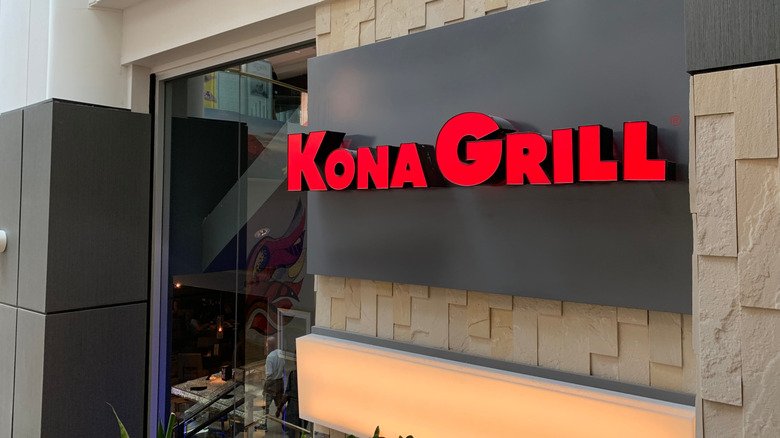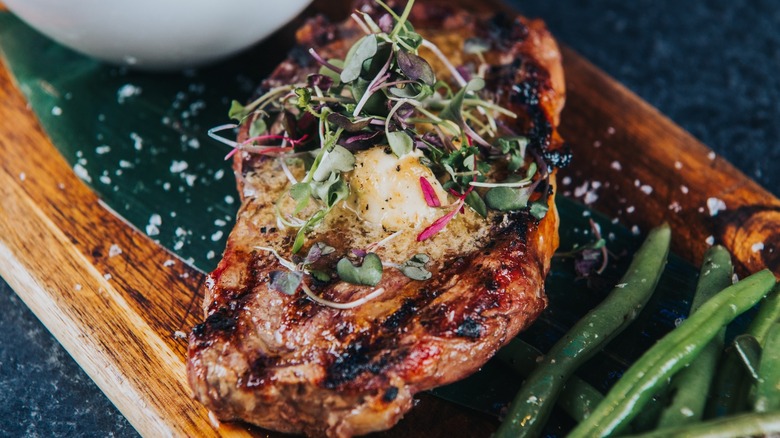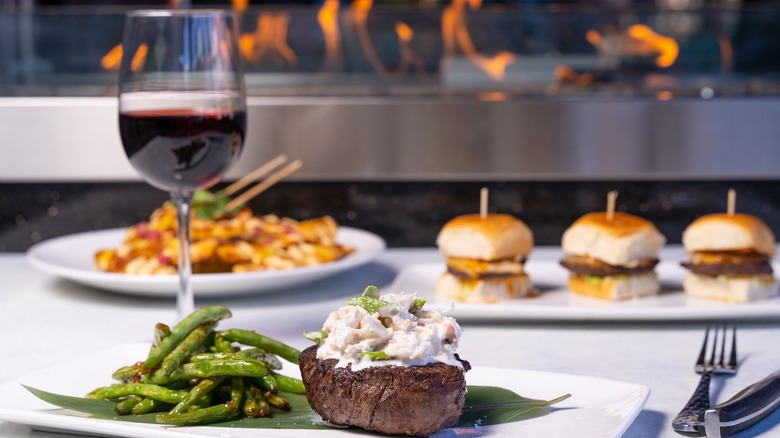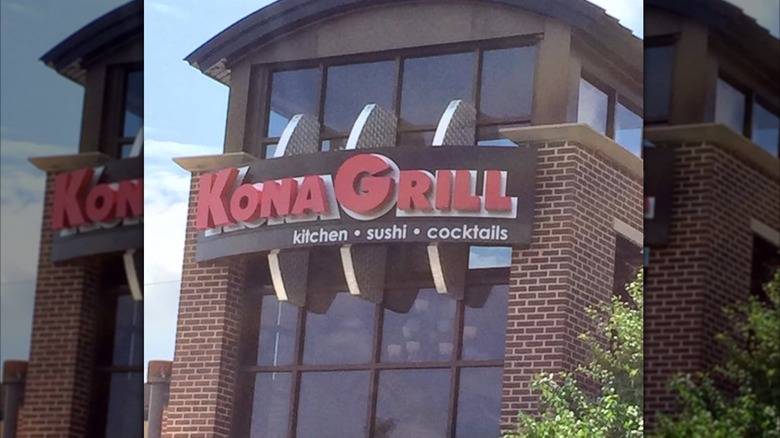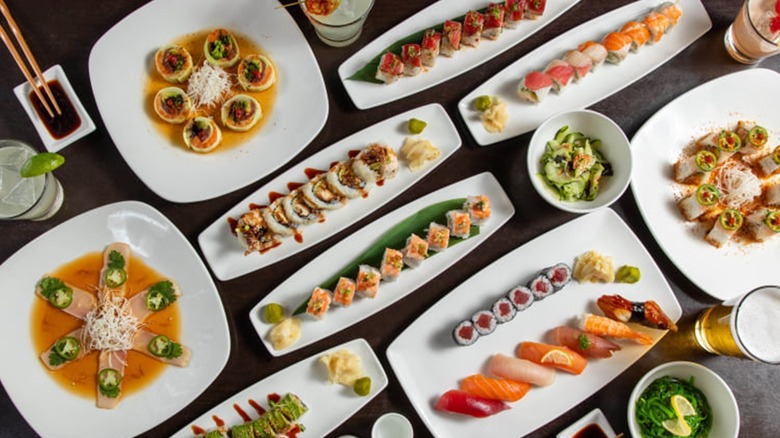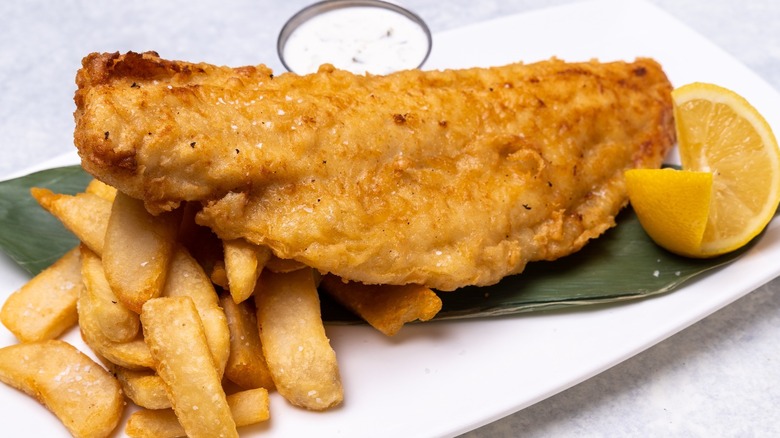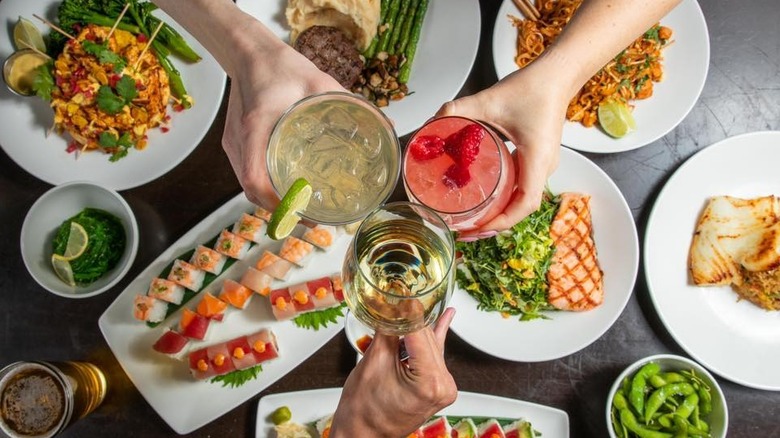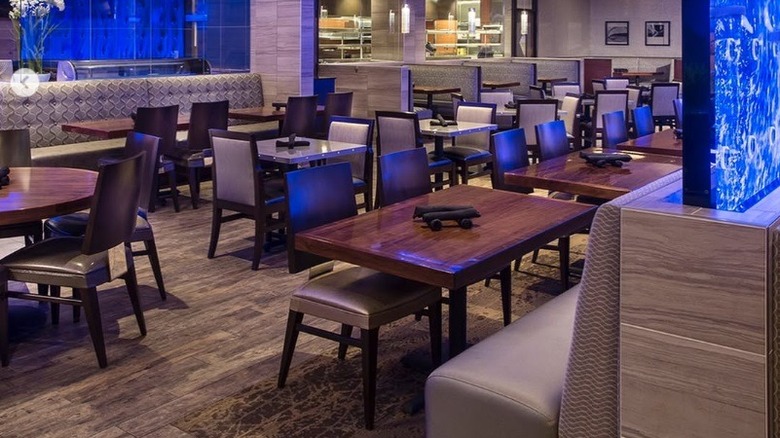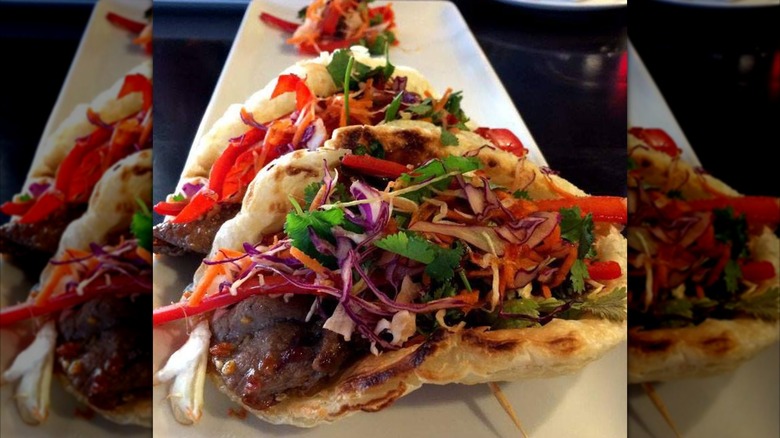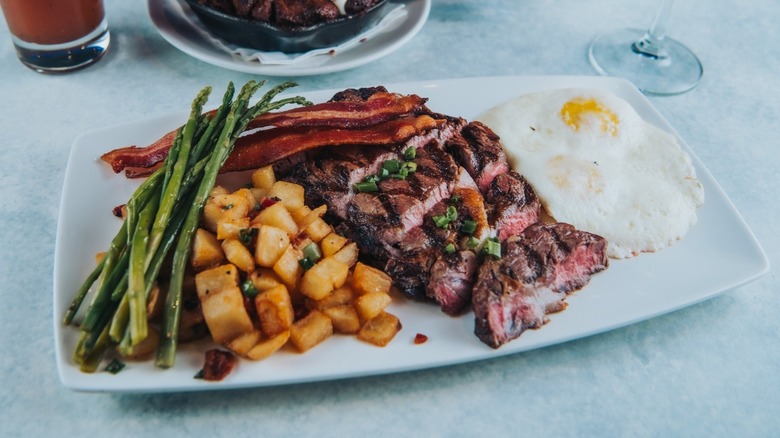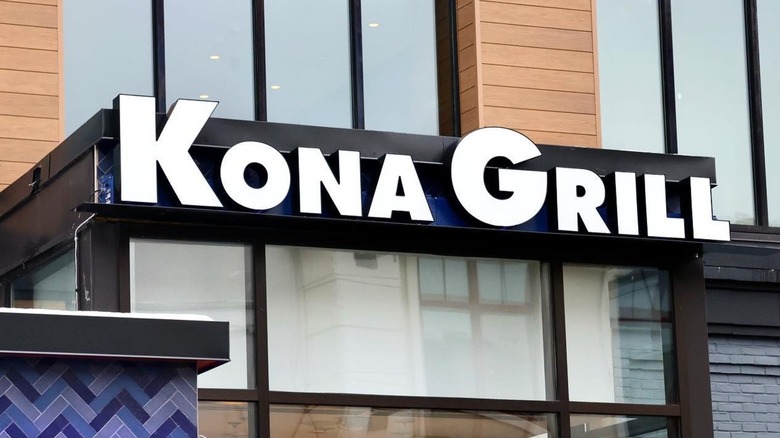Signs Kona Grill Is Struggling To Stay In Business
No restaurant is guaranteed an easy ride in a sea of fast-casual options, and though Kona Grill keeps chugging along, the troubled chain is starting to exhibit indicators that not all is well behind the curtain. It's not a huge surprise, considering the company's considerable issues in recent years, including a bankruptcy and subsequent purchase by a more solvent organization.
While that lifeline was thrown out to buoy the eatery and reestablish a more preferred place in the dining pecking order, it hasn't proven to be the simple salvation that leadership may have expected. Unfortunately, the big brains behind the revamp haven't seen the hearty uptick in sales that would signify Kona is on steady ground just yet.
Even if you're not a frequent Kona Grill customer, an examination of the state of things for this modest collection of upscale dining rooms shows cracks forming. It isn't wrong to wonder if the enterprise ever truly recovered from its 2019 change of hands, or if the best-laid plans of CEOs and chefs have continued to go awry all along the way. Whether it's a drastic reduction in the number of locations around the country or a strategic introduction of new models, programs, and items designed to pique consumer curiosity, there are certain signals being given by Kona that the struggle to sustain is real — and ongoing. Will it be one of the restaurant chains closing in 2025 or will it be a struggling chain restaurant that makes a comeback?
Kona filed for bankruptcy in 2019
Struggle is nothing new for Kona Grill; the company has seen its share of challenges during its nearly 30 years in operation. Having begun as a Scottsdale, Arizona-based restaurant in 1998 and expanding to 26 locations across 17 states by 2014, Kona was never the biggest player on the block. But it filled a niche market for lovers of steak, seafood, and bar bites who enjoy a slightly more upmarket atmosphere than the usual casual dining chains offer. Much of its business came from lunch sales and daytime dining, made more accessible thanks to locations in malls and shopping centers that gave the chain a market that started to slow down when mall visits took a downturn.
When Kona joined the list of restaurants going through bankruptcy scares in 2019, the future may have seemed uncertain for workers and fans of the establishment. After switching CEOs when the company was unable to steady sales and revenue losses, a decline that threatened to knock Kona off of the NASDAQ, Kona was in a spot risky enough to imperil the existence of the restaurant altogether. But this brand wasn't entirely without value to others in the dining sector, and instead of closing down its remaining locations and going out of business entirely, Kona Grill was scooped up by another proprietor that saw potential in the New American outlet. Suddenly, the restaurant had a second chance to become something bigger than it was before.
The chain was purchased by The ONE Group
Unable to pull out of its tailspin, Kona Grill found an opportunity for salvation with The ONE Group, an umbrella group with a variety of restaurants in its auspices, including its most recent acquisition, the popular teppanyaki chain Benihana, as well as STK Steakhouse and RA Sushi. The price for Kona was a cool $25 million in a purchase that took place in fall 2019. Working capital liabilities assumed by The ONE were said to be around $11 million. With this new ownership, Denver, Colorado, became the city of headquarters for the chain, which at the time was operating 24 restaurants in the country. The ONE Group offers what it describes as "vibe dining," a blend of quality food, stellar service, and modern atmosphere, and Kona was presumed to be a fit for the model.
The timing of the purchase didn't do much to help Kona Grill pull off a comeback. The ONE Group took over just months before the COVID pandemic ramped up in spring 2020, which put the entire restaurant industry on its heels and caused creative pivots among even the most successful chains. Having to envision what Kona Grill's second act looked like while being unsure of what the dining sector itself would become on the other side added challenge upon challenge. With a new property beset with troubled operations, The ONE Group would have had an uphill climb getting Kona back to its former glory, let alone surpassing it.
Location count dropped from 46 in 2017 to 27 in 2024
An undeniable indicator that Kona Grill isn't faring as well as hoped is the reduction in locations over the course of operations. In the past seven years, the restaurant count around the country has been reduced from an all-time high of 46 in 2017 by almost half, to 27 in 2024. The ONE Group was able to bring up the count by only three locations after the 2019 purchase. Though there are signs of growth for Kona Grill with new locations finally in the plans for the next several years, there's no speedy expansion that would indicate the struggle for dining supremacy is squarely in Kona's court. Considering what Kona went through in the past, proceeding with caution is advisable — but the slow forward motion feels more like caution flares than celebratory fireworks.
With restaurants scattered throughout the continental U.S. and competition from a cadre of similarly-branded restaurants on the scene, Kona has an array of markets around the country that it can study while determining what measures might help bring the spark back. Seeing such a drastic reduction of locations occur in less than a decade is a stark sign that generous innovation and flexibility are needed to determine what tweaks can bring Kona back into the limelight. The ONE Group's belief that the brand can reach 200 locations around the nation feels like a bit of a pipe dream considering the current performance.
Same-store sales have been down for the better part of two years
Even with the mitigation measures taken by The ONE Group, Kona Grill hasn't been able to entirely get itself back to the desirable position the restaurant chain once enjoyed. Even in the dining sector, corporate culture demands continuous growth, and for a restaurant in which the hopes were for increased rather than decreased revenue, not meeting same-store sales goals is a dark omen for the future.
Figures compared from quarter-to-quarter have shown declines in all but quarter three of 2023, ramping up to a 17% drop in quarter three of 2024. Sales drops are never good news for a corporation, but in a company still climbing its way out of compromise, it's bound to be a source of added anxiety. In the case of Kona Grill, the ongoing drop could feel like the floor falling out of the funhouse before the real thrills have a chance to kick in.
The only remedy for a sales-based downslide is increased traffic, a feat that Kona Grill doesn't seem guaranteed to pull off. With the pandemic far in the rearview mirror, even woes caused by the shut-down can't be blamed for current slippage. The ONE Group leadership seems committed to working with the brand despite the ongoing challenge, though there's bound to be a limit to the amount of loss the chain can take before drastic measures are required to keep losses to a minimum.
The ONE Group is factoring in other restaurant properties to shore up business
With red flags for Kona Grill waving in the wind, The ONE Group has been taking measures to maintain stability for the greater organization without relying solely on Kona's comeback. To help drive traffic toward Kona locations, the company has shuttered several of its RA restaurants, which serve what fans may consider the best sushi in the U.S., though the menu overlaps with Kona fare. In one instance, there were three RA locations near neighboring Kona locales. Eliminating double-up like this will leave only Kona in key regions, giving the restaurant a better chance at capturing more interest.
The purchase was heralded as rocket fuel to help Kona Grill, but The ONE's fellow restaurant STK Steakhouse is being nurtured toward greater success as well, causing the company to split its interests. It may sound like a steakhouse showdown akin to Texas Roadhouse vs. The Capital Grille, but with both parties under the same roof. While this doesn't mean success for one and failure for the other, it does raise the question: Which property does The ONE Group invest in more fully to find success, and will Kona be the sacrifice made in the end to salvage what may have been a less-than-favorable deal? Though it sounds like the plans are for continued expansion, having a built-in competitor could easily alter the roadmap. And if STK Steakhouse pulls ahead, Kona could fall off the map entirely.
Updated concepts are being rolled out to keep up with trends
Any restaurant that hopes to be taken seriously by the public when pulling itself out of struggling times takes extra measures to bring in customers who may not have been aware of the restaurant before. Though return customers may provide reliable sales, being able to get fresh faces seated at the table is a more certain path for growth, and one that chains take great pains to make happen. For Kona Grill, this comes in the form of rolling out new concepts to make the restaurant more appealing. A reimagined layout incorporates less floor space for the kitchen and sushi bar, better tech for back-of-house operations, and a more vibrant atmosphere. Four test locations in Ohio, Utah, Oregon, and Arizona appear to be performing well, helping breathe new life into the operation.
In addition to an upgraded brick-and-mortar impression, a Kona Grill virtual model has also become part of the conversation. Ghost kitchen creators REEF have launched the operation in Austin, Texas, featuring Kona Grill items that can be ordered and delivered outside of full-service restaurants. Though buzz was happening as early as August 2022, there's still chatter about the prospect. While taking advantage of a digital audience is always a smart idea for a company looking to modernize, it also heralds a reach for a restaurant that hasn't fully captivated a devoted enough following from a physical audience.
New menu offerings are showing up to lure customers in
Of course, Kona Grill can launch all the new concepts it wants, but without having menu items that customers crave, no amount of reimagining can satisfy the appetites of diners looking for an exciting place to spend their disposable funds. To update the existing catalog, Kona has introduced featured dishes that help their consumer base make the most of their money while providing imaginative fare that's both fun and high-quality.
The emphasis on affordability in several of these new items is an unmistakable attempt to capture dining dollars. Kona's take on one of the best all-you-can-eat restaurant deals features unlimited sushi between 3 p.m. and close on Sundays. There's also a three-course Taste of Kona $39 prix fixe menu, an offering to try to win the hearts of more discerning diners. Meanwhile, promotional drives like Burger Mania, Power Lunch, and $3 $6 $9 Happy Hours aim to bring in fans of more grounded fare. Pushing brunch appears to be assisting with the sales lift as well.
But it's not a novelty to find new items and promotional opportunities in the casual dining world. While it's a good sign that customers are responding to what Kona is putting on the table, having to keep up with the greater flow in the industry could draw attention away from the grill and put the company back in the hot seat.
Real estate issues are making business tricky
It isn't only customer interest and the challenge to increase sales that are plaguing the struggling chain. Kona grill has also come up against significant challenges regarding the real estate that its restaurants occupy. According to a May 2024 report, the company is experiencing lower sales margins at around 25% of Kona locations due to these real estate issues. Plans to restructure purchasing and supplies and review vendor connections to minimize travel costs sound like attempts to reduce expenses, which could help the bottom line but doesn't address the drop in sales.
In what may ultimately be a damaging move for Kona Grill, The ONE Group has tested the idea of putting virtual Benihana locations inside Kona restaurants based on markets where the two brands don't intersect. This sounds like an effort to maximize existing space without spending funds to expand the Benihana brand, but having two separate concepts exist in a single shell is something reserved for fast-food proprietors like YUM Brands and its KFC-Taco Bell-Pizza Hut hybrids. It definitely doesn't sound like a plan to help Kona Grill capture a greater share of the market.
Dissatisfaction from staff may signal trouble
Early signs of any company headed for bigger issues are sometimes heralded by the opinions of the workers on the ground. When Kona Grill first found itself in trouble, it tried to right the ship by trimming staff, finding out the hard yet obvious fact that restaurants run on humans providing service. Not surprisingly, onsite operations slipped, impacting customer experiences negatively and likely adding to the reasons Kona filed for bankruptcy. Yet after the renewal of the company's footing, word from workers remains up-and-down, a trend that's easy to attribute to the fickleness of humans in general, but which can also be a harbinger of bad things to come.
Workers vocal enough to publish their opinions on Indeed have called out the company's sometimes-toxic environment, stressors fed by poor management, long hours, and the non-existence of a work-life balance. A location in Kansas City, Missouri, even staged a walk-out according to one employee's review. Enough negative feedback of this sort begins to create a picture of a company that still hasn't worked out the kinks, regardless of how sales are going or how many new locations and concepts may be in the works. When you're a company hoping to lift itself to the upper echelons but your workforce isn't on your side, you could be in for a backslide you weren't expecting.
Customers are calling out a drop in quality
Despite Kona Grill's best efforts to balance and reposition itself in a more stable spot on the fast-casual dining circuit, customers haven't been so quick to help prop up the struggling company. Online chatter about how well Kona has met the moment comes with a fair amount of criticism for both the service and the menu at the restaurant.
A Reddit thread detailed the views of several Denver customers discussing the decreased quality they've noticed, despite Kona's attempts at keeping up with modern trends. Comparisons to more widespread chains like Applebee's and Red Lobster describe the food and gimmicky promotions as missing the mark, the exact opposite of what The ONE Group has been aiming for. Of course, some of these issues may be regional and could have to do with the character of the locations themselves. But Yelp reviews from the Desert Ridge location in Arizona note that the food feels too expensive for the quality being offered, aspects which can affect opinions of the entire chain.
No matter how much trouble Kona Grill's parent company takes to repair its standing, if the customers don't embrace it there may be no hope for this once shining steak and seafood operation. Unlike in show business, there is such a thing as bad press in the restaurant industry, and word on the Internet can make or break an eatery's reputation pretty easily once the bad review train rolls out of the station.
